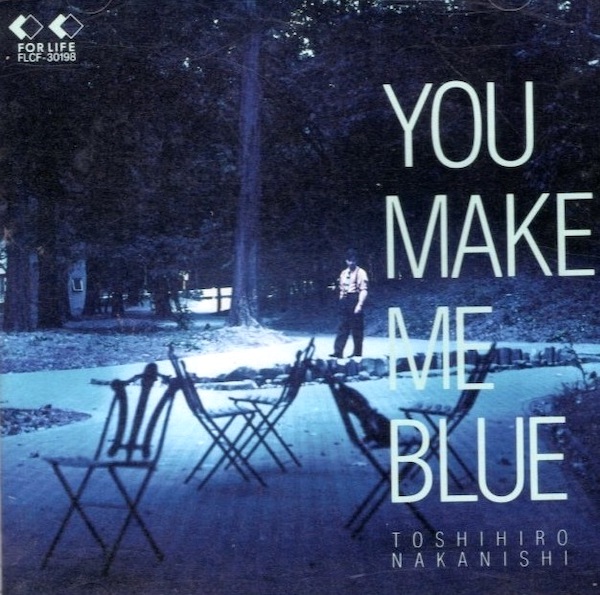
Be honest. How many of you know someone (or are friends or acquaintances) with a certain somebody that in the way they act, the way they dress or think, seem not of this era? I keep thinking of this thought when I go back to Toshihiro Nakanishi’s music and this selection: You Make Me Blue. Just like these characters in our life, you’re used to their quirks – perhaps a genuine love of everything made during the golden age of black and white cinema, or aesthetics fashioned from cast-off twee styles, dated like “last year’s pop song” – it’s what makes them them and in a way makes us expect their ideas to be a view into some relic of the past. Yet, there are special times. There are times when their dated ways surprise us, when they pull something uniquely theirs out of their hats.
Tokyo violinist Toshihiro Nakanishi is just one of those guys you’ve listened to more than actually heard about. In his ‘80s heyday, Toshihiro appeared on records as diverse as Toshifumi Hinata’s Reality In Love or Seigen Ono’s Seigen, all the way to those by Gontiti, Keiko Kimura, and Taeko Ohnuki. It was his signature violin tone that could navigate all the diverse sounds, characters, and styles that Japan was pumping out in the “bubble economy” era. Yet, when you look at his solo work you’d be surprised by how old fashioned it was.

Beginning with 1985’s wildly successful Fiddler In Wonderland, Toshihiro (as solo artist) created music that harkened back to a time when pop music meant the kind of music you took popcorn to watch perform. It’s the music of Guy Lombardo. The champagne swing of Lawrence Welk. When the most colorful jazz you could’ve heard could only be readily seen on the silver screen. While in America, where I live, “easy listening” has been decidedly moribund for nearly half a century, in Japan, Toshihiro was one of those in the post-WWII generation leading the fight to find ways to resurrect the genre, differently.
On Toshihiro’s debut, standards like “Winnie-The-Pooh” and “When You Wish Upon A Star” take on a different glow. In his 20s, early success on the Interface label allowed Toshihiro to indulge, musically, like he was born for the ‘20s. His sophomore release, Silent Romance (featuring other F/S faves like Tomoyuki Asakawa and Febian Reza Pane), found him easing further down that path. Where others would choose to push the envelope, Toshihiro found his pocket – easing out Parisian-tinged parlor music, lightening up light pop – and used his day job to keep those more cerebral, workshopped ideas where they made more sense. So, unless you have a hankering for the purest vanilla, you’d be hard pressed to find reasons to explore (or expect) anything else from him. Yet, in 1992, we have Fuji TV to thank for this one.
In 1992, Fuji TV came to Toshihiro with the proposition to soundtrack their upcoming short-lived drama, “わがままな女たち” (which roughly translates to “Selfish Women”). As the surprising title made clear, this drama presented a dramatic change of tone for him. Forget the pap, sap, or maud, what a drama full of “serious” stories – stories of infidelity and palace intrigue – needed was a soundtrack that could navigate what viewers would see on the TV screen. This is where Toshihiro’s dramatic reinvention wasn’t that – it was an evolution in plain sight.
On what would become the soundtrack “Selfish Women”, You Make Me Blue, Toshihiro would explore and flesh out the hidden melancholia and bittersweetness in his music. Perhaps under the influence of more modal jazz music, the sound of You Make Me Blue gained a darker hue. Songs like opener “ユー・メイク・ミー・ブルー(プロローグ) – You Make Me Blue (Prologue)” appear of that lineage heard in the music of friend Toshifumi Hinata or of Yuriko Nakamura. This was neoclassical music inspired not by the concert hall but by the scenery of a rainy night, the shadows of a lonely day, the panoply of emotion between you and me.
Although we’d still hear glimpses of the joyful Toshihiro we all know and love, on songs like “ジガティ・ジグ(パート1) – Jiggety-Jig (Part 1)”, most songs we’d hear would imbibe in a deeper state of being. Songs like “ユー・メイク・ミー・ブルー – You Make Me Blue”, “ラ・パーラ – La Perla” and “アイ・ミスアンダースタンド – I Misunderstand”, all originals, strike on myriad, yearning motifs, more apt for aimless walks on silent back alleys, than heard as background music while seated in a café waiting for a certain special someone. For once, we hear Toshiro show us that other side of him that could be emotional in a different way.
“ハーフ・ムーン – Half Moon” comes at us with a fiery electric violin pushing us through some hard-nosed fusion worth its 6-minute length. “イン・ユア・メイズ – In Your Maze” are impressionistic mood pieces that move gentle plate tectonics until their heavy motions are felt. “トリプル・フェイス – Triple Face” uses ambient sonics to flesh out a trapezing set of floating music a bit alien to anything he’d ever done before. Everywhere on this album, you’ll hear Toshihiro airing his heart out, through the only instrument he ever truly mastered.

So, a huge debt of thanks goes out to Francis (for once again) sharing with me this hidden Japanese jazz gem that sheds light on someone you might now know now but know now in a different way. Here’s to more, frankly, timeless “deep easy listening” pieces like this one.
